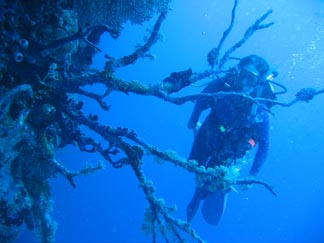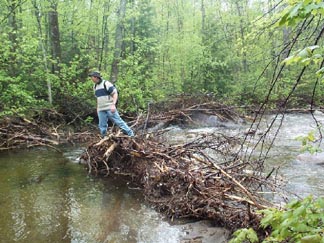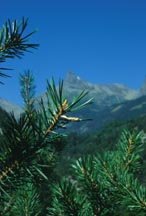From fruit-eating fish to ice storm damage in forest streams, Cornell researchers explore ecological issues at annual meeting
By Susan Lang

Drew Harvell
Jessica Ward assessing a dead sea fan on a wall in Palau at approximately 60-foot depth.

Clifford Kraft
Graduate student Dana Warren, M.S. '02, examines accumulations of in-stream wood that resulted from the 1998 ice storm in an eastern Adirondacks creek.

Andrea Battisti
An egg mass of the pine processionary moth on a Scots pine tree near Mont Avic, Italian Alps, one of the regions where the moth has recently expanded to high elevations.
Fruit-eating fish in South America help disperse fruit trees during flood season. Fungi that attack sea fans get even nastier when the tropical waters warm by just a few degrees, and although sea fans counterattack with upgraded defenses, the fungi win out. A moth that attacks pine trees has expanded its range in the past three decades, and tests show that global warming is to blame.
These are just three of the research results that almost 50 Cornell University scientists will present at the Ecological Society of America's 90th annual meeting, Aug. 7-12, in Montreal. More than 4,000 people are expected to attend.
Below are some highlights of the work to be presented:
- Fruit-eating fish in South America are so heavily fished that they may not be commercially viable in 20 years. Yet a new study by Cornell graduate student Jill Anderson and her adviser, Alexander Flecker, associate professor of ecology and evolutionary biology (EEB), find that fish that eat fruit not only are critical in dispersing fruit seeds during flood season -- carrying them five miles in three days in some cases -- but also deposit the seeds into flooded forests, where the seeds germinate much more quickly after the floods recede than seeds that remain in fruit pulp.
- Corals such as seas fans are very sensitive to temperature fluctuations and are greatly stressed in today's oceans. Using one of the most thoroughly characterized coral-disease systems in the world in the Caribbean, Cornell graduate student Jessica Ward and her adviser, Drew Harvell, associate professor, EEB, have found that sea fans produce more potent antifungal compounds when the water temperature increases by just 3 degrees Fahrenheit. "But unfortunately for the sea fans, the fungus compensates for this increase in potency by growing faster and therefore overwhelming the efforts of the sea fans to fight them off," said Ward. "This indicates that very small changes in temperature can have large impacts on the system."
- The pine processionary moth attacks pine trees in the Mediterranean and in the past three decades has expanded its range boundary some 54 miles north and 750 feet in elevation in the Italian Alps. By determining the minimum nest and night-air temperatures required for the moth larval feeding, Cornell graduate student Michael Stastny (EEB) and Andrea Battisti of the University of Padova, Italy, tested larval colonies at ever colder sites to see how they fare. "We found that the recent warming trend in the region has been driving the expansion of the moth's range by increasing winter survival," explained Stastny. "We expect that global warming will continue to enhance the moth's survival in previously prohibitive environments, causing further latitudinal and altitudinal expansion. Our work highlights the need to develop temperature-based predictive models for future range shifts of winter-limited species, with potential applications in management."
- Fish play a critical role in recycling nutrients in tropical freshwaters, and different fish recycle nutrients at very different rates. Cornell researchers have conducted the first study exploring how individual fish species contribute to aggregate nutrient cycling and thus how eroding biodiversity may affect processes in species-rich ecosystems. Based on work in both a massive lake in tropical Africa and a river in South America, their findings suggest that depleting particular species, perhaps through overfishing or changes to the habitat, can significantly alter nutrient cycling in these ecosystems. "The implication of this work is that human modification of the make-up of animal communities can have subtle yet insidious consequences for ecosystem functioning," said Peter McIntyre, doctoral student in EEB, working with Flecker and with Make Vanni and Jim Hood from Miami University, Ohio.
- Ice storms are known to damage trees and forests yet may benefit lakes and streams. Cornell postdoctoral associate Andrew Millward, his adviser, Clifford Kraft, associate professor of fishery and aquatic sciences in the Department of Natural Resources, and graduate student Dana Warren, M.S. '02, examined satellite images of Adirondack forests damaged by the unprecedented 1998 ice storm. "Forest edges along streams and lakes were significantly more susceptible to ice storm damage, and these waters contained large amounts of wood that increased nutrient retention and fish habitat," said Kraft. "These results add to the evidence that ice storms can shape aquatic ecosystems within forested landscapes and highlight the importance of the boundary between forests and aquatic ecosystems."
- In comparing conventional grain farms that used simplified rotations and received typical inputs of inorganic nitrogen fertilizer to organic farms with diversified, legume-based rotations, Laurie Drinkwater, professor of horticulture, found that total organic carbon and nitrogen concentrations in conventionally managed soils were 40 percent smaller than those of organically managed soils. There were corresponding differences in microbially mediated nitrogen transformations between organically and conventinally managed soils. "Our findings support the idea that integrated management of carbon and nitrogen cycles in agricultural systems alters internal nitrogen cycling processes so that retention of nitrogen is promoted," said Drinkwater.
Media Contact
Get Cornell news delivered right to your inbox.
Subscribe